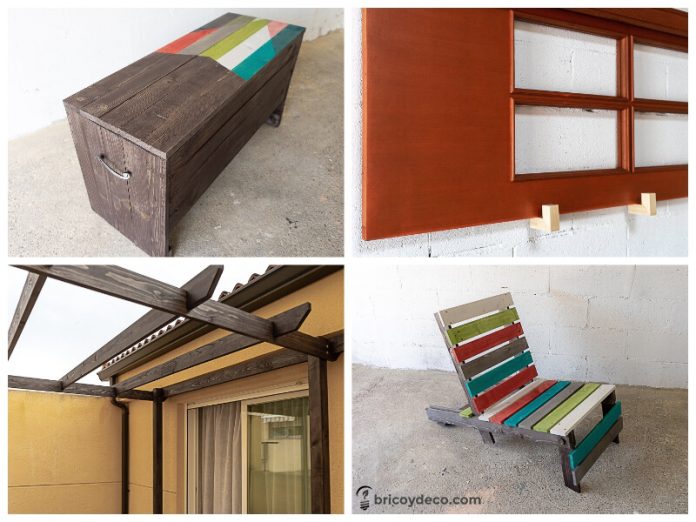
Would you like it protect and decorate the wood preserving the natural beauty of its grain? Did you know that there is a single product that will also preserve it from the action of the sun, rain and fungi? It is called lasur and is ideal for outdoor furniture. Thanks to it you can renew and update your terrace or garden furniture by changing its color or tone, but without losing the class and elegance of this noble material.
If you found my guides on wood finishes useful, you cannot miss this guide to protect your terrace and garden furniture with lasur. It will help you provide them with a second life in an economical and simple way and with a single product.
What is lasur?
Lasur is a protector for “open pore” wood that penetrates through its pores and protects it from the inside, allowing it to breathe. For this reason, wood stains are ideal for outdoor furniture, since they allow the humidity of the wood to be regulated by facilitating the escape of water vapor from its interior, allowing it to adapt to the contractions and expansions typical of this material.
In addition to keeping the wood healthy since they incorporate fungicide treatments, the stains highlight its natural beauty by not completely covering the grain.
In the market you can find solvent-based and water-based stains, although the latter are the most recommended for outdoor wood. On the other hand, lasur has the advantage that you can give a layer of solvent-based lasur and another on top of water-based lasur, for example.

How to protect and decorate wood with lasur
In the following video tutorial you will find lasur application tips and tricks:
In summary:
- The stains can be applied by brush or roller, although the use of an acrylic bristle brush or trowel that does not leave hair is preferably recommended. In this way we ensure that the product penetrates better.
- The wood must be free of varnish or paint before applying the lasur. If so, it should be removed by sanding or with a stripping product.
- When it comes to spreading the product, it should be done in very thin layers to avoid peeling. It is also not recommended to sand between layers so as not to reduce the effectiveness of the protective property of the lasur.
What types of lasures exist?
In addition to colorless lasur and the usual wood colors (oak, walnut, cherry, etc.), you can find lasures of different colors. For example, Luminos has an 18-color chart that stands out for the following characteristics:
- They are water-based and their composition is as ecological as possible.
- They do not have any odor and dry very quickly (15 minutes).
- They protect from fungal growth.
- The colors are transparent and very bright, their hue varying according to the light it receives and the type of wood on which it is applied.
- The LuminosCold range contains pigments that reflect infrared rays (IR), protecting the wood from heating by solar radiation.

How often do I have to renew a lasur?
Like any other protector for wood, the lasur must be renewed from time to time. Its durability will depend on the exposure and use of the furniturebut it can hold up perfectly for a couple of years.
When you want to give a new layer, it is not necessary to sand beforehand, although it is recommended to clean the surface with a pressure gun. After 24 hours for the wood to have dried completely, the new layer of lasur will be applied.

Differences between lasur and other outdoor protectors
There are other products that are also to protect outdoor wood such as oil and varnish.
lasur vs oil
The oil finish also protects the “open pore” wood, although lasur provides a more durable finish. While with oil it is recommended to repeat the process a couple of times a year, with lasur you can wait a couple of years or more.
In addition, the stains contain biocides that protect the wood against mold or fungus formation.
Lasur vs varnish
The varnish is a “closed pore” finish, that is, it forms a film on the wood. For this reason lasur is more appropriate for exteriors than varnishsince the varnish cracks over time due to changes in humidity that occur in the wood.
On the other hand, water-based stains offer greater resistance to outdoor wood than varnish.

Lasur Frequently Asked Questions
The following lasur frequently asked questions They will help you solve any doubts you may have about this protector for wood.
- Can it only be applied on solid wood? Although lasur is mainly intended for the protection of wood, can be used on any porous surface such as wood veneer, clay or cement, providing them with a finish and protection in the same way.
- How many layers should be applied? A minimum of 2 is recommended and not more than 5 or 6 coats as this can saturate the wood and cause the lasur to crack.
- Can lasur be applied on tropical wood? In the case of tropical woods, it is preferable to previously apply a treatment against tannins. In this post you will find more information about what tannins are.
- Is a primer required before applying lasur? No, but it will be necessary to apply a treatment that eliminates xylophages from the wood if the wood is affected. It must be taken into account that although the lasur incorporates fungicidal treatments, these are preventive and do not eliminate existing pests.
- Can you mix two different colors or shades of lasur? Yes, but they should be from the same range to ensure that the mixture will be homogeneous.

did you know the lasur to protect and decorate wood? Have you ever used it? In particular, it is a product that I use frequently since I love it for its ability to highlight the natural beauty of wood.
If you liked this post, visit , you will find many more practical guides and DIY projects.



